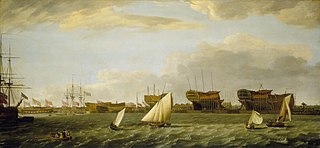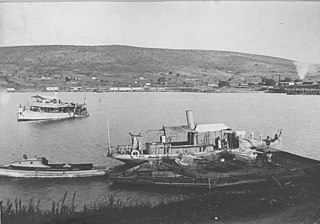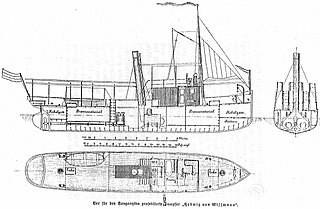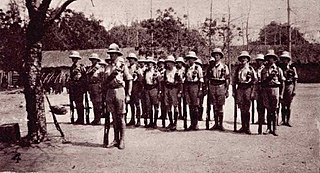
Lake Malawi, also known as Lake Nyasa in Tanzania and Lago Niassa in Mozambique, is an African Great Lake and the southernmost lake in the East African Rift system, located between Malawi, Mozambique and Tanzania.

A gunboat is a naval watercraft designed for the express purpose of carrying one or more guns to bombard coastal targets, as opposed to those military craft designed for naval warfare, or for ferrying troops or supplies.

Mangochi is a township in the Southern Region of Malawi. Located near the southern end of Lake Malawi, in colonial times it used to be called Fort Johnston. As of 2018 it has a population of 53,498.

Mimi and Toutou Go Forth: The Bizarre Battle for Lake Tanganyika is the fourth book by author Giles Foden. It was published in 2004 by Michael Joseph. The United States edition, published in 2005 by Knopf, is entitled Mimi and Toutou's Big Adventure: The Bizarre Battle of Lake Tanganyika.

Hermann Wilhelm Leopold Ludwig Wissmann, after 1890 Hermann von Wissmann, was a German explorer and administrator in Africa.

Buccochromis rhoadesii is a species of haplochromine cichlid. It is endemic to Lake Malawi, Lake Malombe and the upper Shire River in the countries of Malawi, Mozambique, and Tanzania.

SMS Vineta was a protected cruiser of the Victoria Louise class, built for the German Imperial Navy in the 1890s. Vineta was laid down at the AG Vulcan shipyard in 1895, launched in April 1897, and commissioned into the Navy in July 1898. The ship, named for the semi-legendary medieval town of Vineta, was armed with a battery of two 21 cm guns and eight 15 cm guns and had a top speed of 19 knots.

Blackwall Yard is a small body of water that used to be a shipyard on the River Thames in Blackwall, engaged in ship building and later ship repairs for over 350 years. The yard closed in 1987.

MV Chauncy Maples is a motor ship and former steamship that was launched in 1901 as SS Chauncy Maples. She spent her entire career on Lake Malawi and was regarded as the oldest ship afloat in Africa. After more than one hundred years' service it was intended to restore her for use as a floating medical clinic to support the several million lakeshore dwellers whose average life expectancy is 44 years. The Government of Malawi offered support for this in 2009 and charity fundraising was sufficient to make progress. The hull was found to be beyond repair at a viable cost so a more practical modern craft was proposed to give ambulance service around the lake.

Chauncy Maples (1852–1895) was a British clergyman and Anglican missionary who became Bishop of Likoma, with a diocese in East Africa.

The Battle for Lake Tanganyika was a series of naval engagements that took place between elements of the Royal Navy, Force Publique and the Kaiserliche Marine between December 1915 and July 1916, during the First World War. The intention was to secure control of the strategically important Lake Tanganyika, which had been dominated by German naval units since the beginning of the war. The British forces – consisting of two motor boats named HMS Mimi and Toutou – were under the command of the eccentric Lieutenant-Commander Geoffrey Spicer-Simson. The boats were transported to South Africa and from there by railway, by river, and by being dragged through the African jungle, to the lake.

HMS Fifi was an armed screw steamer, captured from the Germans by Royal Navy units during the Battle for Lake Tanganyika, and used to support Anglo-Belgian operations on the lake and its surrounding areas. She had previously been operated by the Germans under the name Kingani named after the river Kingani.

The Great Lakes Patrol was carried out by American naval forces, beginning in 1844, mainly to suppress criminal activity and to protect the maritime border with Canada. A small force of United States Navy, Coast Guard, and Revenue Service ships served in the Great Lakes throughout these operations. Through the decades, they were involved in several incidents with pirates and rebels.

Liuli, formerly known as Sphinx Hafen, is a settlement on the Tanzanian shore of Lake Malawi in the Mbinga District of Ruvuma province. It is notable for being the site of the first naval action of World War I.

Hermann von Wissmann was a German steamer on Lake Nyasa named after the German explorer Hermann von Wissmann who had raised funds for the vessel to be built in 1890 as an anti-slavery gunboat.

The Hedwig von Wissmann was a German steamboat on Lake Tanganyika, which became a feature in the story behind the film The African Queen. She was sister vessel to the larger Hermann von Wissmann on Lake Nyasa, and like that vessel originally used as a gunboat against slavers. Hedwig von Wissmann was the wife of the German explorer and colonial administrator Hermann von Wissmann who had raised funds for both boats.

SMS Schwalbe was an unprotected cruiser built for the German Kaiserliche Marine, the lead ship of the Schwalbe class. She had one sister ship, Sperber. Schwalbe was built at the Kaiserliche Werft in Wilhelmshaven; her keel was laid down in April 1886 and her completed hull was launched in August 1887. She was commissioned for service in May 1888. Designed for colonial service, Schwalbe was armed with a main battery of eight 10.5-centimeter (4.1 in) guns and had a cruising radius of over 3,000 nautical miles ; she also had an auxiliary sailing rig to supplement her steam engines.
Lake Malawi Museum is a museum on Lake Malawi in Malawi. Situated in the Old Gymkhana Club and organized by the Society of Malawi since 1971, the museum is located near the Queen Victoria memorial near the Bakili Muluzi Bridge in Mangochi town, Mangochi District, within the Southern Region of Malawi.

The Nyasaland Volunteer Reserve (NVR) was a reserve infantry unit in the British protectorate of Nyasaland. The British Central Africa Volunteer Reserve was formally established by the colonial government in 1901 and was renamed when the protectorate became Nyasaland in 1907. In the initial years the unit was little more than a rifle shooting club with no uniform and no military training. The NVR was placed on a more formal standing in 1908 under the Volunteer Ordinance. This implemented residency and racial requirements for membership and made provision for the unit to be mobilised by the governor. The unit was initially formed of four sections but grew to seven sections by 1914 and by 1930 the unit had ten.
MV Vipya was a motor vessel used as a passenger-cargo ship that sailed on Lake Malawi in Southern Africa from 1944 to 1946. The ferry had a tonnage of 470 tons, was 140 feet (43 m) in length, 27 feet (8.2 m) in breadth, and had a twin crew. Equipped with a motor engine, it could travel up to a speed of 12 knots. It was built to carry 315 passengers and 100 tons of cargo. On July 30, 1946, the ship set sail with 194 passengers on board. It was caught up in a storm near Chilumba in Karonga where it capsized and sank. The disaster resulted 145 passengers and crew on board drowning. No remains of the bodies have been recovered. The sternwheel ferry disaster is the worst shipwreck in Malawi's history.


















